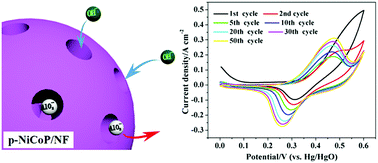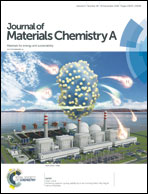Porous NiCoP in situ grown on Ni foam using molten-salt electrodeposition for asymmetric supercapacitors†
Abstract
The construction of in situ grown porous structures can enlarge the contact area between electrodes and electrolyte and shorten the distance for ion diffusion, boosting the electrochemical properties of electrode materials. Herein, we combine molten-salt electrodeposition and AlP-assisted solvothermal phosphorization to design porous NiCoP in situ grown on Ni foam (p-NiCoP/NF). Even with a high mass loading of 10.1 mg cm−2, the as-prepared p-NiCoP/NF exhibits a remarkable mass specific capacity (Qm) of 1279.2 C g−1 (0.99 A g−1) and good rate capability. Furthermore, the p-NiCoP/NF//AC device, assembled using p-NiCoP/NF and active carbon (AC), presents a high energy density of 45.5 W h kg−1 at a power density of 124.2 W kg−1 and superior cycling stability (92.86% retention after 10 000 cycles). Finally, we introduce a four-electrode system to study the effect of the potential window of the positive and negative electrodes in an asymmetric supercapacitor (ASC) on its energy density, where it boosts the energy density and rate capability at the optimal working state.



 Please wait while we load your content...
Please wait while we load your content...